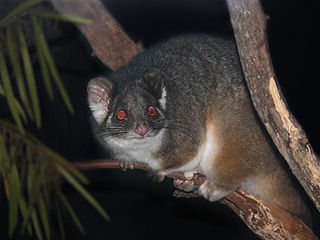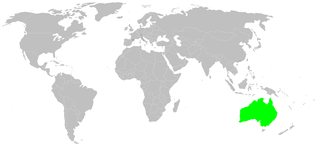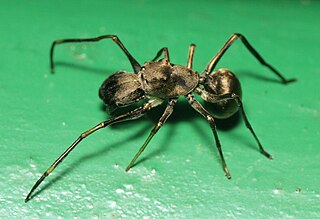
The earless seals, phocids, or true seals are one of the three main groups of mammals within the seal lineage, Pinnipedia. All true seals are members of the family Phocidae. They are sometimes called crawling seals to distinguish them from the fur seals and sea lions of the family Otariidae. Seals live in the oceans of both hemispheres and, with the exception of the more tropical monk seals, are mostly confined to polar, subpolar, and temperate climates. The Baikal seal is the only species of exclusively freshwater seal.

A mammary gland is an exocrine gland in humans and other mammals that produces milk to feed young offspring. Mammals get their name from the Latin word mamma, "breast". The mammary glands are arranged in organs such as the breasts in primates, the udder in ruminants, and the dugs of other animals. Lactorrhea, the occasional production of milk by the glands, can occur in any mammal, but in most mammals, lactation, the production of enough milk for nursing, occurs only in phenotypic females who have gestated in recent months or years. It is directed by hormonal guidance from sex steroids. In a few mammalian species, male lactation can occur. With humans, male lactation can occur only under specific circumstances.

Weaning is the process of gradually introducing an infant human or another mammal to what will be its adult diet while withdrawing the supply of its mother's milk.
Production of milk (lactation) from a male mammal's mammary glands is well-documented in the Dayak fruit bat and the Bismarck masked flying fox. The term "male lactation" is not used in human medicine. It has been used in popular literature, such as Louise Erdrich's The Antelope Wife, to describe the phenomenon of male galactorrhea, which is a human condition unrelated to childbirth or nursing. Newborn babies of both sexes can occasionally produce milk. This is called neonatal milk and not considered male lactation.

Breast milk or mother's milk is milk produced by mammary glands located in the breast of a human female. Breast milk is the primary source of nutrition for newborns, containing fat, protein, carbohydrates and variable minerals and vitamins. Breast milk also contains substances that help protect an infant against infection and inflammation, whilst also contributing to healthy development of the immune system and gut microbiome.

Dairy cattle are cattle bred for the ability to produce large quantities of milk, from which dairy products are made. Dairy cattle generally are of the species Bos taurus.

Alloparenting is a term used to classify any form of parental care provided by an individual towards young that are not its own direct offspring. These are often referred to as "non-descendant" young, even though grandchildren can be among them. Among humans, alloparenting is often performed by a child's grandparents and older siblings. Individuals providing this care are referred to using the neutral term of alloparent.

The common ringtail possum is an Australian marsupial.

Myrmarachne is a genus of ant-mimicking jumping spiders that was first described by W. S. MacLeay in 1839. They are commonly called ant-mimicking spiders, but they are not the only spiders that have this attribute. The name is a combination of Ancient Greek μύρμηξ, meaning "ant", and ἀράχνη, meaning "spider".
A trophic egg is an egg whose function is not reproduction but nutrition; in essence, the trophic egg serves as food for offspring hatched from viable eggs. In most species that produce them, a trophic egg is usually an unfertilised egg. The production of trophic eggs has been observed in a highly diverse range of species, including fish, amphibians, spiders and insects. The function is not limited to any particular level of parental care, but occurs in some sub-social species of insects, the spider A. ferox, and a few other species like the frogs Leptodactylus fallax and Oophaga, and the catfish Bagrus meridionalis.

Phryganoporus candidus, also known as the foliage web spider, is a small, subsocial jumping spider endemic to Australia. On average, they are 6–10 mm long and are a mottled brown colour, covered in silvery grey hair. They typically reside in arid and semi-arid locations, building their nests in various trees, bushes, and other plant-life. They have a mutualistic relationship with Acacia ligulata, and therefore prefer to build their nests in these trees.

Parental care is a behavioural and evolutionary strategy adopted by some animals, involving a parental investment being made to the evolutionary fitness of offspring. Patterns of parental care are widespread and highly diverse across the animal kingdom. There is great variation in different animal groups in terms of how parents care for offspring, and the amount of resources invested by parents. For example, there may be considerable variation in the amount of care invested by each sex, where females may invest more in some species, males invest more in others, or investment may be shared equally. Numerous hypotheses have been proposed to describe this variation and patterns in parental care that exist between the sexes, as well as among species.

Amaurobius ferox, sometimes known as the black lace-weaver, is a common nocturnal spider belonging to the family Amaurobiidae and genus Amaurobius. Its genus includes the permanently social species A. socialis, and three subsocial species, A. fenestralis, A. similis and A. ferox, all three of which have highly developed subsocial organizations.

Breastfeeding, or nursing, is the process by which human breast milk is fed to a child. Breast milk may be from the breast, or may be pumped and fed to the infant. The World Health Organization (WHO) recommends that breastfeeding begin within the first hour of a baby's life and continue as often and as much as the baby wants. Health organizations, including the WHO, recommend breastfeeding exclusively for six months. This means that no other foods or drinks, other than vitamin D, are typically given. WHO recommends exclusive breastfeeding for the first 6 months of life, followed by continued breastfeeding with appropriate complementary foods for up to 2 years and beyond. Of the 135 million babies born every year, only 42% are breastfed within the first hour of life, only 38% of mothers practice exclusive breastfeeding during the first six months, and 58% of mothers continue breastfeeding up to the age of two years and beyond.

Lactation describes the secretion of milk from the mammary glands and the period of time that a mother lactates to feed her young. The process naturally occurs with all sexually mature female mammals, although it may predate mammals. The process of feeding milk in all female creatures is called nursing, and in humans it is also called breastfeeding. Newborn infants often produce some milk from their own breast tissue, known colloquially as witch's milk.
Infant feeding is the practice of feeding infants. Breast milk provides the best nutrition when compared to infant formula. Infants are usually introduced to solid foods at around four to six months of age.
In aquatic mammals, maternal transfer is the movement of contaminants from mother to offspring, typically of lipophilic contaminants while in utero or through the mother's milk. This has become important with the increase in usage of persistent organic pollutants (POPs). POPs biomagnify due to their lipophilic nature and become accumulated in the lipid tissues of aquatic mammals. These lipids are used as energy for the mother during the development of offspring, which releases the POPs into the circulatory fluid. This leads to a transfer of the toxicants into the developing embryos during gestation as well as into milk that an aquatic mammal produces during lactation.

Matriphagy is the consumption of the mother by her offspring. The behavior generally takes place within the first few weeks of life and has been documented in some species of insects, nematode worms, pseudoscorpions, and other arachnids as well as in caecilian amphibians.
Vertebrate maternal behavior is a form of parental care that is specifically given to young animals by their mother in order to ensure the survival of the young. Parental care is a form of altruism, which means that the behaviors involved often require a sacrifice that could put their own survival at risk. This encompasses behaviors that aid in the evolutionary success of the offspring and parental investment, which is a measure of expenditure exerted by the parent in an attempt to provide evolutionary benefits to the offspring. Therefore, it is a measure of the benefits versus costs of engaging in the parental behaviors. Behaviors commonly exhibited by the maternal parent include feeding, either by lactating or gathering food, grooming young, and keeping the young warm. Another important aspect of parental care is whether the care is provided to the offspring by each parent in a relatively equal manner, or whether it is provided predominantly or entirely by one parent. There are several species that exhibit biparental care, where behaviors and/or investment in the offspring is divided equally amongst the parents. This parenting strategy is common in birds. However, even in species who exhibit biparental care, the maternal role is essential since the females are responsible for the incubation and/or delivery of the young.

Toxeus is a genus of jumping spiders first described by Carl Ludwig Koch in 1846. The genus was synonymized with Myrmarachne by Eugène Simon in 1901, and remained a synonym until revived by Jerzy Prószyński in 2016, when he split up Myrmarachne.















